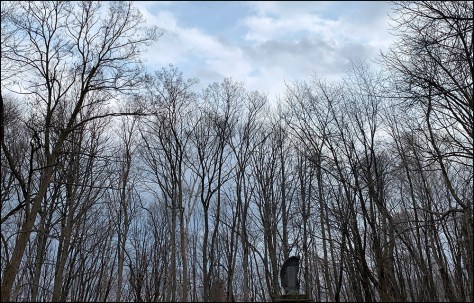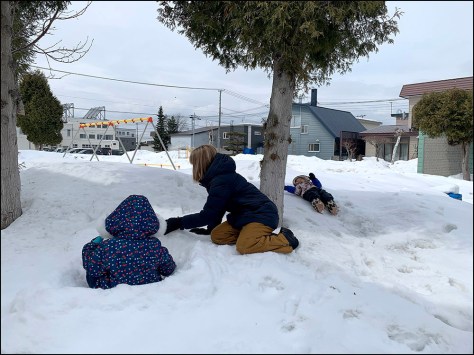Jūni – Familiar and unfamiliar paths

It feels good to be back in Asahikawa although my Japanese family has moved house from directly opposite the picturesque Tokiwa Koen to the suburb of Suehiro, which means I can no longer easily walk to Heiwa-dori Kaimono Koen, or stride out on to the network of stop banks that run along the perimeters of the many rivers and tributaries. According to the Japan Experience site, Asahikawa is situated on the confluences of the Ishikari, Biei, Chubetsu and Ushibetsu rivers, and there are over 700 bridges in the city. This fact doesn’t surprise me. It just seems unusual on this visit not to be able to see the lovely Ishikari river.
Snow melt

Back on 18 March when I disembarked from my bus at Toyo Hotel, it was still wintry, with snow piled everywhere and people hurrying about their business, not keen to be outside in the chilly air any longer than necessary. After settling in, I’ve tried to keep up with a daily walk, not just for exercise (and to counteract the extra food I’m eating), but also to get a feel for my new surroundings. To begin with there was little sign of spring growth, and I often had to negotiate deep snow and slippery icy footpaths.
Gradually the snow has become less and less and has for the most part completely melted.

Snow of any kind is a novelty for me and I’m glad I arrived at a time when there was still some around, but I have to admit that in the past few days when the temperature has reached the low 20s C it’s been much easier to get out and about. I did see one solitary heap of snow dribbling into the gutter yesterday but I doubt it will be there tomorrow.

First pleasures and small disappointments
What have I most enjoyed so far? Well, being reunited with my daughter, her husband and my two grandchildren after a long and uncertain two and a half years, would have to claim 1st place hands down. But after that I think that it’s just nice to be back. And of course I love the interesting items that can be purchased here, and the varieties of food. And because it’s Spring and I love gardening, it’s especially interesting to see which plants are coming up now that the snow has gone. I can barely keep up as they are they are forcing their way into the light and flowering at a much quicker rate than they would in a New Zealand October.

What I’m disappointed with is the fact that even though I’ve been studying Japanese relatively steadily over the past few months, the things I’ve managed to learn are of little use in real life. My Japanese language is too slow and I lack confidence. My ears aren’t tuned in to the individual syllables and I still haven’t been able to learn katakana well enough. My hiragana is fine, but I’ve realised that you do really need to know katakana equally well if you are to read any of the instructions, menu descriptions and the various signs. I suspect that you can probably manage without Kanji to a certain extent… But as far as actually speaking the language, I’ve found that even the simple phrases that I’m really familiar with, the ones I know well, they just fly out of my head when I have the chance to use them.
A Kiwi in a strange land

Perhaps that heading should rather be, “A strange Kiwi in a new land”. I don’t usually post photos of myself but I think my expression probably captures what I look like when I’m out and about. Or it would if I wasn’t usually wearing a mask. I forgot about that!
My daughter tells me that there are other foreigners here, but so far I haven’t seen a single one in all my walkings around. Small Japanese children look at me sideways and older children, aged about nine or ten, often openly stare. Those locals who are unfortunate enough to have to interact with me, such as customer service staff at the supermarkets, konbini or cafes, are very kind and helpful. And my Japanese extended family are wonderful. Kind, courteous, they have welcomed me with open arms and have truly done everything they can to make me feel part of their family.
Being in a country where no-one speaks your language is a good way to make you think about how you behave yourself, when encountering people with English as a second language. I think that Pakeha New Zealanders can be a bit smug about the whole language thing and be very impatient and intolerant of those who struggle with English.
Takasu Shrine

Last Monday I walked to the end of one of the main roads nearby and came across an interesting flight of stairs leading up to a tree-clad hill.
I was expecting possibly a leafy suburb or a small park and was surprised to discover the Takasu Shinto shrine at the top. In Summer when all the trees are clad in their greenery, it will be very pretty up there.
I was hesitant to venture too far within the enclosed area but later learned that it would have been okay to have gone in to look around the gardens. Instead I walked around the grounds in front of the building but outside the Torii. There were a number of large rocks with inscriptions on them, as well as the trunk of an old tree that had been cared for.
I took a photo of the text written by the remains of the tree as I was curious about it. According to Google Translate, (and we all know that it’s not the ideal translation tool), the words say something like this;
Rising cherry blossoms – An old cherry tree that had fallen from its roots due to a typhoon in September 2001 was repaired by Makoto Sugawara, who visited for prayer in May 2003, using a 50-ton crane. Mr Hitoshi Igarashi, the priest at the time, named it ‘Okiagari Sakura’.
Something different

When I first arrived in Asahikawa the nights were very cold, and although my room was well-heated, I was given a Yutanpo, a Japanese hot water bottle. I used this for a week or so, then decided to order a more familiar type online. These days, the most common versions of the Yutanpo are made of hard plastic! Exactly like the one in the photo above, and even though it comes with a soft cotton sleeve, it’s very different from the rubber version I had as a child. Though I suspect it’s also less likely to perish and fall apart in your bed than those old rubber ones were.
I’ve since seen many of the same type for sale in shops and online, but I was glad when my new soft more familiar version arrived in the mail, complete with cuddly hedgehog cover.




